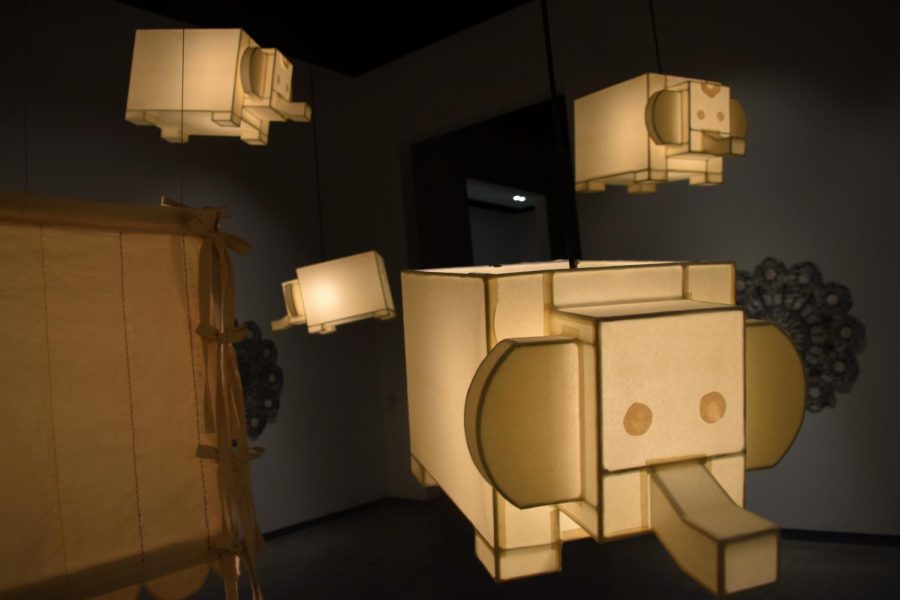Jordan Schnitzer Museum of Art to open
Jordan Schnitzer, President Schulz, Jim Olson to speak at opening reception
MICHAEL LINDER | The Daily Evergreen
Artist Jeffry Mitchell’s display, “The Death of Buddha,” features floating elephants. This part of the exhibit explores nature and humanity.
April 5, 2018
The Jordan Schnitzer Museum of Art, also known as the Crimson Cube, is opening at noon Friday. The new museum, designed by Jim Olson of Olson Kundig, features six new galleries and 10,000 square feet of gallery space.
The new building will not only be the viewing place for WSU’s permanent art collection, but the Schnitzer collection as well.
“If the experiment we call America is going to survive, it’s because generations of young people will become the problem-solvers the world needs,” wrote Jordan Schnitzer, the building’s main donor. “This new museum will reach out to every student on campus, every young person in the surrounding counties, every adult within hundreds of miles – providing activities that will enrich their hearts, minds and souls.”
The Crimson Cube, as it is affectionately referred to by the staff and directors of the museum, has been in the making for the past 10 years. The design has gone through many changes over that time, said Debby Stinson, Museum of Art marketing and public relations manager.
“Originally, we wanted to put LED screens all over the outside of the museum, to project images and make it a beacon for art on campus,” Stinson said. “However, when we saw the cost of those screens, we went for something different.”
Stinson added that although the screens were no longer a part of the plan, there was still room to make it a beacon, as discovered by the architect of the museum.
“The idea of putting glass around the building made it what we’re looking for,” she said, “and it really reflected the idea that art mirrors life.”
The museum will regularly rotate through its exhibits, showing pieces from both its own collections and the Jordan Schnitzer Collection. Currently, there are several exhibits on display, including “Trimpin’s Ambiente432,” a sound sculpture that makes music through horns activated by motion sensors.

“Trimpin’s Ambiente432,” a sound sculpture that makes music through horns activated by motion sensors, is on display in the museum.
Another exhibit features Marie Watt’s “Companion Species,” which features a large cedar sculpture of a wolf, as well as a variety of pieces that explore connections between humanity and nature.
“We wanted pieces that were beautiful and inclusive,” Curator Ryan Hardesty said, “pieces that foster these themes, and promote positive discussion.”
Costing close to $15 million to build, the museum was funded almost entirely by private individuals, and primarily by Schnitzer, a prominent business leader and philanthropist.
“[Schnitzer] wants to be to art museums what Carnegie was to public libraries,” Stinson said.
She said Schnitzer was unable to resist the continued barrage of funding requests from those working on the museum. Stinson said Schnitzer bought his first art piece at 14, and he wishes to share art with all and allow pieces to impact people across the nation and the world.
Free to all on campus, the Jordan Schnitzer Museum of Art will have its opening reception at noon Friday. Schnitzer, WSU President Kirk Schulz and museum architect Jim Olson will speak at the reception, and tours will be given throughout the last half of the day.

















